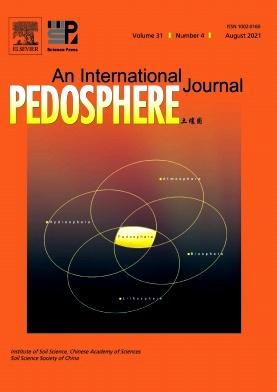Effects of soil amendment and foliar selenium applications on cadmium immobilization in soil and accumulation in wheat
IF 5.2
2区 农林科学
Q1 SOIL SCIENCE
引用次数: 0
Abstract
Wheat cadmium (Cd) contamination is one of the environmental and agricultural concerns worldwide. Here, the effects of applications of foliar selenium (Se) and soil amendments (lime, mixture of biofuel ash and sodium sulfide (DSO), and mixture of iron mine tailing and alkali lignin (MX)) on soil Cd fractions and wheat Cd accumulation were studied using laboratory incubation, greenhouse pot, and field plot experiments. In the laboratory incubation experiment, lime and MX applications significantly increased soil pH, DSO application significantly decreased soil pH, while all the three amendments significantly reduced soil bioavailable Cd fractions by 16%–21% compared to the control without any amendment. Foliar Se application significantly increased the growth and yield of the high-Cd-accumulating cultivar (Puxing5). In the greenhouse experiment, lime and MX applications considerably decreased grain Cd concentration by 55% and 47%, respectively, for Puxing5 and by 24% and 26%, respectively, for the low-Cd-accumulating cultivar (Zhoumai30). In the field experiment, grain Cd concentration was significantly reduced by 68% and 72% by lime and MX applications, respectively, for Puxing5. Application of DSO also significantly reduced grain Cd concentration by 58% for Puxing5 and 25% for Zhoumai30 in the greenhouse experiment, but increased grain Cd concentration by 22% for Puxing5 in the field experiment. Our results implicate that laboratory incubation and greenhouse experiment results are necessary to be verified in field, and foliar Se application is recommended when considering both financial costs and production safety.
土壤改良剂和叶面施硒对土壤镉固定化和小麦积累的影响
小麦镉(Cd)污染是全球关注的环境和农业问题之一。本文采用室内培养、温室盆栽和田间小块试验,研究了叶面硒(Se)和土壤改良剂(石灰、生物燃料灰与硫化钠混合物、铁矿尾矿与碱木质素混合物)对土壤Cd组分和小麦Cd积累的影响。在室内培养试验中,石灰和MX施用显著提高了土壤pH值,DSO施用显著降低了土壤pH值,而三种改良剂均显著降低了土壤生物有效Cd组分,比未加任何改良剂的对照降低了16% ~ 21%。叶面施硒显著提高了高cd积累品种(蒲星5号)的生长和产量。在温室试验中,施用石灰和MX显著降低了浦星5号籽粒Cd浓度,分别降低了55%和47%,降低了低Cd积累品种周麦30的籽粒Cd浓度,分别降低了24%和26%。在田间试验中,施用石灰和MX可显著降低浦星5号籽粒Cd浓度,分别降低68%和72%。在温室试验中,施用DSO显著降低了浦星5号和周麦30籽粒Cd浓度,分别降低了58%和25%,而在田间试验中,施用DSO使浦星5号籽粒Cd浓度提高了22%。本研究结果表明,室内培养和温室试验结果有必要在田间验证,考虑到财务成本和生产安全,建议叶面施用硒。
本文章由计算机程序翻译,如有差异,请以英文原文为准。
求助全文
约1分钟内获得全文
求助全文
来源期刊

Pedosphere
环境科学-土壤科学
CiteScore
11.70
自引率
1.80%
发文量
147
审稿时长
5.0 months
期刊介绍:
PEDOSPHERE—a peer-reviewed international journal published bimonthly in English—welcomes submissions from scientists around the world under a broad scope of topics relevant to timely, high quality original research findings, especially up-to-date achievements and advances in the entire field of soil science studies dealing with environmental science, ecology, agriculture, bioscience, geoscience, forestry, etc. It publishes mainly original research articles as well as some reviews, mini reviews, short communications and special issues.
 求助内容:
求助内容: 应助结果提醒方式:
应助结果提醒方式:


